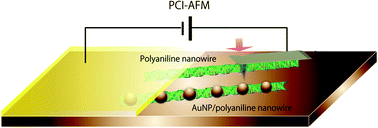Novel charge transport in DNA-templated nanowires†
Abstract
The rapid development of DNA nanotechnology over the past decade has enabled the self-assembly of conducting building blocks towards the construction of conductive

* Corresponding authors
a Graduate School of Chemical Sciences and Engineering, Hokkaido University, Kita13, Nishi8, Kita-Ku, Sapporo 006-8628, Japan
b Graduate School of Science, Osaka University, 1-1 Machikaneyama, Toyonaka 560-0043, Japan
c
Research Institute for Electronic Science, Hokkaido University, Kita 21, Nishi 10, Kita-Ku, Sapporo 001-0021, Japan
E-mail:
ijiro@poly.es.hokudai.ac.jp
Fax: +81-11-706-9361
Tel: +81-11-706-9361
d JST-CREST, Sanban-cho 5, Chiyoda-ku, Tokyo 102-0075, Japan
e The Institute of Scientific and Industrial Research, Osaka University, 8-1 Mihogaoka, Ibaraki, Osaka 567-0047, Japan
The rapid development of DNA nanotechnology over the past decade has enabled the self-assembly of conducting building blocks towards the construction of conductive

 Please wait while we load your content...
Something went wrong. Try again?
Please wait while we load your content...
Something went wrong. Try again?
G. Wang, H. Tanaka, L. Hong, Y. Matsuo, K. Niikura, M. Abe, K. Matsumoto, T. Ogawa and K. Ijiro, J. Mater. Chem., 2012, 22, 13691 DOI: 10.1039/C2JM31839C
To request permission to reproduce material from this article, please go to the Copyright Clearance Center request page.
If you are an author contributing to an RSC publication, you do not need to request permission provided correct acknowledgement is given.
If you are the author of this article, you do not need to request permission to reproduce figures and diagrams provided correct acknowledgement is given. If you want to reproduce the whole article in a third-party publication (excluding your thesis/dissertation for which permission is not required) please go to the Copyright Clearance Center request page.
Read more about how to correctly acknowledge RSC content.
 Fetching data from CrossRef.
Fetching data from CrossRef.
This may take some time to load.
Loading related content
